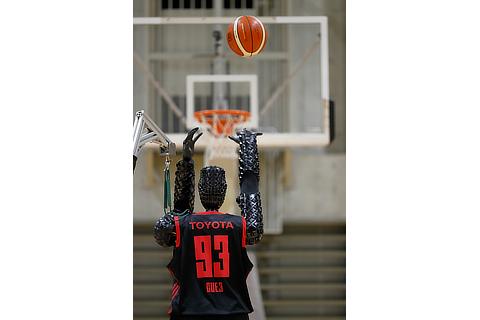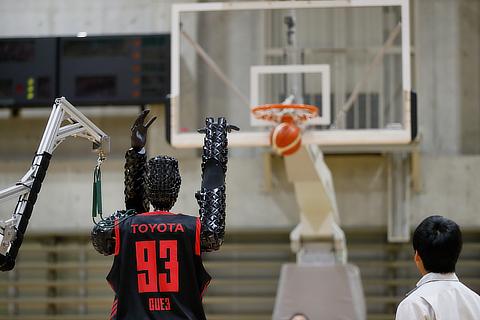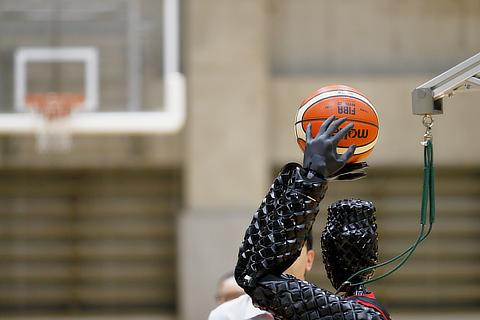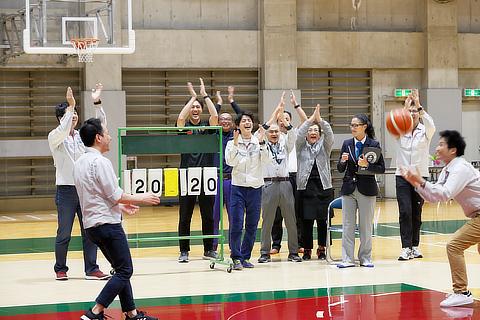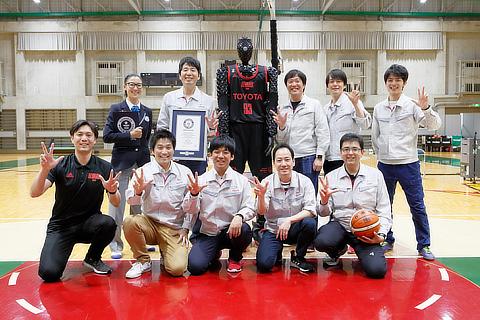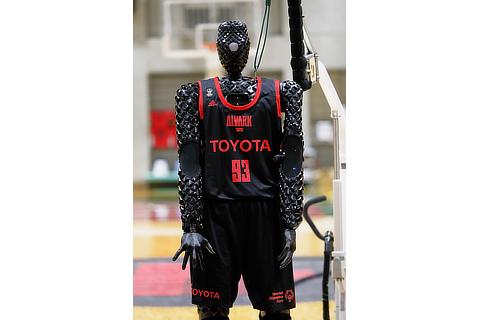Jun. 24, 2019
The Development Diary of CUE, the AI Basketball Robot: Second storyCUE3 Shoots for a Guinness World Records™
- CUE was originally developed by Toyota volunteers in their free time as an AI basketball-playing robot that scores 100 percent of its shots. Now for a limited period until 2020, development of the robot is officially part of the team's work.
- For further details, please see the first Development Diary article.
CUE3 Attempts to Set a Guinness World Records!?
In May 2019, a month after the CUE3 was unveiled, the CUE Development Team was presented with a significant opportunity. Guinness World Records had made an offer; the title was "Most consecutive basketball free throws by a humanoid robot (assisted)". It was an ideal title for a world record―and for the team, the offer held great significance.
In this edition of "The Development Diary of CUE," we take a look at the history of the CUE Project, and go behind the scenes of the team's attempt to set a Guinness World Records.
What is a Guinness World Records?
The majority of readers may have heard of Guinness World Records before. It is an organization that officially gathers and certifies all manner of world records. There are approximately 50,000 applications to attempt to set a world record every year, and Guinness World Records itself also makes inquiries to people, objects, and acts that have the potential to set or become a world record.
In March 2018, when CUE was still being developed voluntarily by Toyota employees in their free time, the then development team had already received an inquiry. At that time, however, after CUE had taken a shot, it took three minutes to prepare the robot for the next shot; its shots could not therefore be regarded as "consecutive," and the team was also worried about CUE's endurance. For this reason, the team regretfully decided to decline the inquiry.
Guinness World Records
In 1951, Sir Hugh Beaver, who was then managing director of the Guinness Brewery, was enjoying hunting in Ireland when the following question was posed: "Which was the fastest game bird in Europe?" This question became an opportunity to create a book that contained information regarding various world records. A new edition of Guinness World Records is released every year, and the book is sold in more than 100 countries worldwide. As for Toyota, The Toyota Corolla was recognized in 2005 as "the world's first passenger car to sell more than 30 million units".
A Second Chance
The team had given up on setting a Guinness World Records, but strangely, a year later, it was offered a second chance.
Since May 2018, when development on CUE officially became part of its work, the team had pressed forward with developing the next-generation CUE. On November 28, 2018, despite encountering a variety of problems beforehand, the team unveiled CUE2 at the half-time show of the match between Alvark Tokyo and Kyoto Hannaryz, and the robot successfully scored a three-point throw.
-
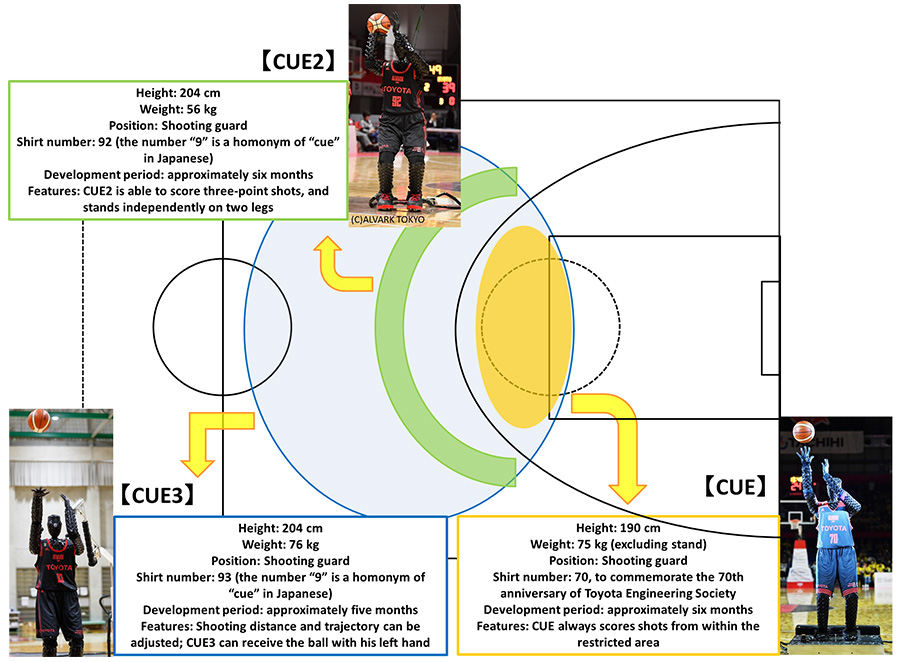
- The evolution of CUE
Five months later, on April 10, 2019, CUE3 was unveiled at the match between Alvark Tokyo and Sunrockers Shibuya. On this occasion, however, a problem arose at the pre-match rehearsal; CUE3 was unable to land a single one of its signature super-long throws from the center-line, approximately 12 meters away.
The actual performance: CUE3 stands on the brink.
Cheers of "Let's Go, CUE3!" rang out around the arena. Hoping for the best, the team looked on as CUE3 entered its shooting stance. With the eyes of the entire arena on it, CUE3 released his super-long throw. The ball described a beautiful arc before landing flush in the net. The arena erupted.
The team members pumped their fists, while team's project leader Tomohiro Nomi leapt up and hugged Minami, the MC, in delight.
This super-long throw was uploaded to the official B.League Twitter account, and spread rapidly across the internet; the following day, it had reached the U.S., the home of basketball. It featured on the social media accounts of ESPN and other leading U.S. television sports channels, became a hot topic across the country, and remained so for a while afterwards.
Upon hearing this news, Guinness World Records once again put forward an inquiry to the CUE Development Team. After a year of implementing a variety of improvements and overcoming numerous challenges, the team had once again been given the chance to set a record. Immediately, it began preparations for setting the Guinness World Records.
Shoot Camp
The team made two major changes in preparation for its Guinness World Records challenge. First, it had to realize "consecutive" throws. Previously, CUE3 would drop its arm after shooting as part of its follow-through; the team therefore made improvements so that, after shooting once, CUE3 could immediately start preparing for a second shot.
Second, the team needed to check the effects of consecutive shots on CUE3's mechanics and motors. It therefore instigated a 200 free throw challenge. In this way, the team prepared thoroughly for the record attempt.
The Challenge Begins
On the day of the record attempt, the Official Adjudicator explained the rules to the team. At Guinness World Records, it sets a goal which at least needs to meet even if no one has challenged its attempt ever. This time, the goal was 5 consecutive shots. The team had previously imagined that it would be allowed three attempts at the record, with the best attempt becoming the official record; on the day, however in fact, if CUE3 threw five or more throws successfully, it would not be permitted to re-attempt the record. In other words, if CUE3 successfully shot five throws, then missed the sixth, the record would stand as "five throws"―even though this would be an easy record to beat.
In addition, after starting a record attempt, the team would not be permitted to make any changes to the robot, nor would it be permitted to check the robot's shooting form without the ball in hand.
Ball pressures, shooting distances, and the height of the basket were also rigorously checked (as it happens, the basket was found to be tilted by two millimeters as a result of dunks by Alvark players).
The team conducted its final rehearsal before the actual record attempt. Since the plan was for the members to switch every 50 throws, each individual carefully checked every movement; indeed, because the attempt was likely to take a long time, operational errors were a particular worry.
The record attempt finally began amid great tension.
The team sweated over each shot.
Failure was not an option. Simply placing each ball in CUE3's hand was a battle of nerves.
The opening five throws were a success. This was enough to set a Guinness World Records, but not a single person relaxed. The team's attempt on the record had only just begun.
Thirty throws... soon it would be 100...
CUE3 quietly continued to sink its shots.
CUE3 surpassed the 200 shots it attempted during the rehearsal. From here on, the team was entering unfamiliar territory. No one knows what might happen, and there were concerns about CUE3's mechanical endurance.
Five hundred throws… 800 throws. Perhaps it was the tension, but no one spoke.
Amid the silence, only the sound of the ball hitting the net echoed around the hall.
Three hours eighteen minutes after the start of the record attempt, CUE3 succeeded in scoring its landmark 1,000th shot; still the attempt continued.
For those who had followed the evolution of CUE from the first generation, this was perhaps an unbelievable achievement. On the other hand, some readers may feel that throwing a ball in the same place every time is rather easy. Indeed, watching CUE3 matter-of-factly scoring throw after throw, it did seem rather easy.
However, until just half a year ago, CUE required a minute's preparation time after every shot; when the adjustments were not quite right, it often happened that CUE was unable to score even once every 30 shots. Yet, now, CUE3 was shooting with unerring accuracy every 12 seconds.
For a humanoid robot to throw a basketball, a variety of technological problems must be overcome. For example, the trajectory of the ball changes according to how the ball is placed in and how it leaves the robot's hand; the force of each throw results in minor changes to the robot's position; and, even when attempting to throw an identical shot, the supply current and power is liable to change. By facing up to each of these problems and implementing improvements, the team succeeded in creating a robot with the technology and endurance to score more than 1,000 consecutive shots.
A robot that had originally been developed from scratch by amateurs had, almost unnoticed, made incredible progress.
In part due to time constraints, the team set its goal for this record attempt at 2,020 shots, in support of the Tokyo 2020 Olympic and Paralympic Games.
As it happens, the Official Adjudicator is duty-bound to observe the record attempt to the very end, and is not permitted to be substituted by another official, or even go to the toilet or eat any food―the conditions are incredibly arduous. This record attempt was therefore a serious undertaking both for the CUE3 Development Team and for the Official Adjudicator.
Setting a goal increased the pressure.
After continually throwing for more than six hours, CUE3 sank its 2,000th shot; only a few more throws remained.
Six hours and thirty-five minutes after the start of the record attempt, the moment the team had been waiting for finally arrived.
The team had officially set its long-desired Guinness World Records: "Most consecutive basketball free throws by a humanoid robot (assisted)―2,020." The entire team was ecstatic at receiving its first-ever official world record certificate.
Basically, Guinness World Records will make its inquiries to people, objects, and acts that encourage people all over the world and symbolize the progress of the times.
Project leader Nomi commented: "For this record attempt, we remained members of Toyota but also collaborated with a professional sports team, and embarked on a challenge that no one else had undertaken; we engaged seriously in manufacturing in the form of robot development; and, as adults, we devoted ourselves to a single goal and rejoiced at achieving our goals. We would be delighted if as many people as possible developed an interest in basketball, robots, and manufacturing as a result of watching our efforts."
The next goal for the CUE Development Team is to take part in the B.League All Stars Game in January 2020. Will CUE3 evolve further into CUE4? Let us wait and see!



























